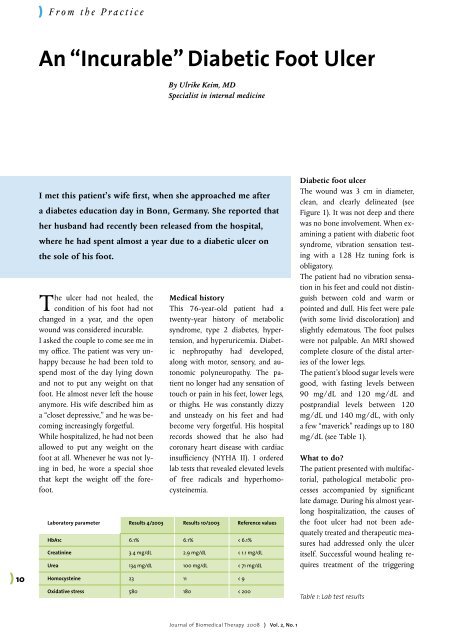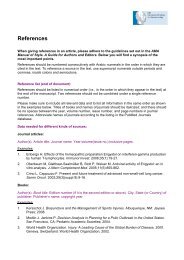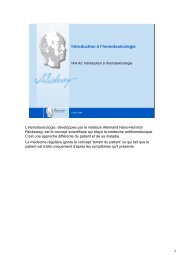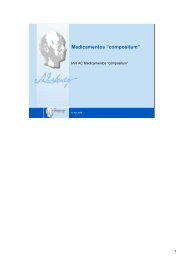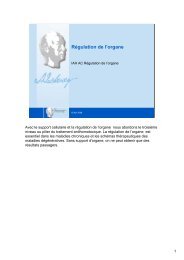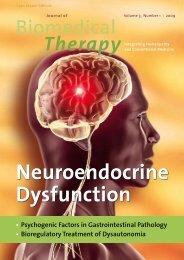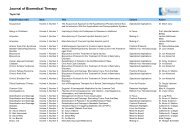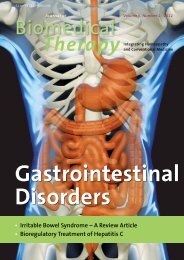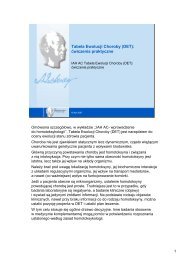Metabolic Syndrome - International Academy of Homotoxicology
Metabolic Syndrome - International Academy of Homotoxicology
Metabolic Syndrome - International Academy of Homotoxicology
You also want an ePaper? Increase the reach of your titles
YUMPU automatically turns print PDFs into web optimized ePapers that Google loves.
) From the Practice<br />
An “Incurable” Diabetic Foot Ulcer<br />
By Ulrike Keim, MD<br />
Specialist in internal medicine<br />
) 10<br />
I met this patient’s wife first, when she approached me after<br />
a diabetes education day in Bonn, Germany. She reported that<br />
her husband had recently been released from the hospital,<br />
where he had spent almost a year due to a diabetic ulcer on<br />
the sole <strong>of</strong> his foot.<br />
The ulcer had not healed, the<br />
condition <strong>of</strong> his foot had not<br />
changed in a year, and the open<br />
wound was considered incurable.<br />
I asked the couple to come see me in<br />
my <strong>of</strong>fice. The patient was very unhappy<br />
because he had been told to<br />
spend most <strong>of</strong> the day lying down<br />
and not to put any weight on that<br />
foot. He almost never left the house<br />
anymore. His wife described him as<br />
a “closet depressive,” and he was becoming<br />
increasingly forgetful.<br />
While hospitalized, he had not been<br />
allowed to put any weight on the<br />
foot at all. Whenever he was not lying<br />
in bed, he wore a special shoe<br />
that kept the weight <strong>of</strong>f the forefoot.<br />
Medical history<br />
This 76-year-old patient had a<br />
twenty-year history <strong>of</strong> metabolic<br />
syndrome, type 2 diabetes, hypertension,<br />
and hyperuricemia. Diabetic<br />
nephropathy had developed,<br />
along with motor, sensory, and autonomic<br />
polyneuropathy. The patient<br />
no longer had any sensation <strong>of</strong><br />
touch or pain in his feet, lower legs,<br />
or thighs. He was constantly dizzy<br />
and unsteady on his feet and had<br />
become very forgetful. His hospital<br />
records showed that he also had<br />
coronary heart disease with cardiac<br />
insufficiency (NYHA II). I ordered<br />
lab tests that revealed elevated levels<br />
<strong>of</strong> free radicals and hyperhomocysteinemia.<br />
Laboratory parameter Results 4/2003 Results 10/2003 Reference values<br />
HbA1c 6.1% 6.1% < 6.1%<br />
Creatinine 3.4 mg/dL 2.9 mg/dL < 1.1 mg/dL<br />
Urea 134 mg/dL 100 mg/dL < 71 mg/dL<br />
Homocysteine 23 11 < 9<br />
Oxidative stress 580 180 < 200<br />
Diabetic foot ulcer<br />
The wound was 3 cm in diameter,<br />
clean, and clearly delineated (see<br />
Figure 1). It was not deep and there<br />
was no bone involvement. When examining<br />
a patient with diabetic foot<br />
syndrome, vibration sensation testing<br />
with a 128 Hz tuning fork is<br />
obligatory.<br />
The patient had no vibration sensation<br />
in his feet and could not distinguish<br />
between cold and warm or<br />
pointed and dull. His feet were pale<br />
(with some livid discoloration) and<br />
slightly edematous. The foot pulses<br />
were not palpable. An MRI showed<br />
complete closure <strong>of</strong> the distal arteries<br />
<strong>of</strong> the lower legs.<br />
The patient’s blood sugar levels were<br />
good, with fasting levels between<br />
90 mg/dL and 120 mg/dL and<br />
postprandial levels between 120<br />
mg/dL und 140 mg/dL, with only<br />
a few “maverick” readings up to 180<br />
mg/dL (see Table 1).<br />
What to do?<br />
The patient presented with multifactorial,<br />
pathological metabolic processes<br />
accompanied by significant<br />
late damage. During his almost yearlong<br />
hospitalization, the causes <strong>of</strong><br />
the foot ulcer had not been adequately<br />
treated and therapeutic measures<br />
had addressed only the ulcer<br />
itself. Successful wound healing requires<br />
treatment <strong>of</strong> the triggering<br />
Table 1: Lab test results<br />
Journal <strong>of</strong> Biomedical Therapy 2008 ) Vol. 2, No. 1


